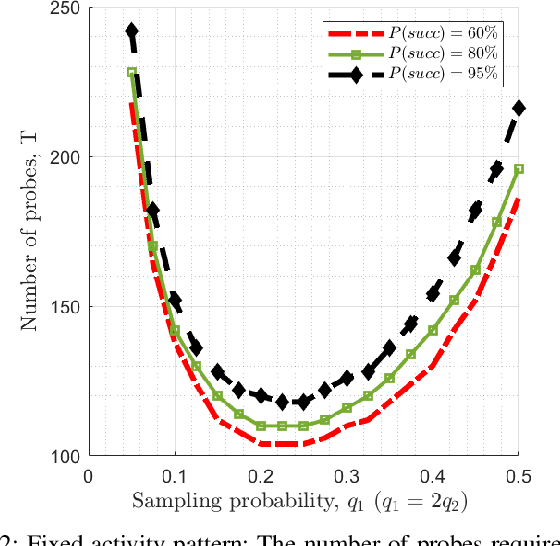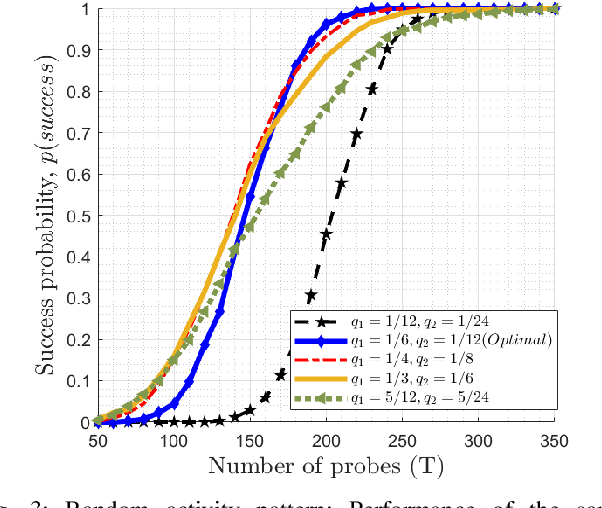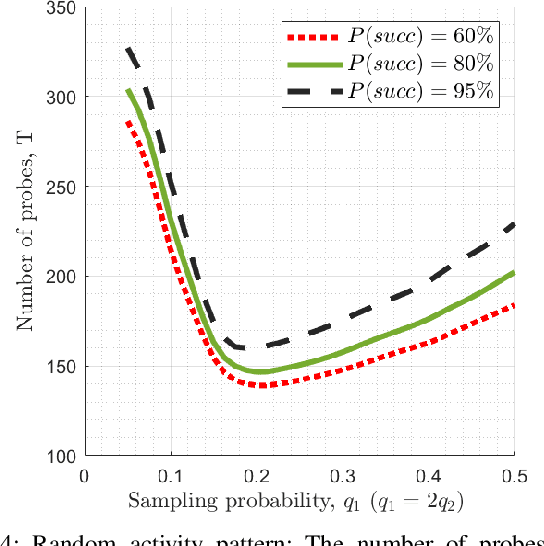Jyotish Robin
Towards Efficient Device Identification in Massive Random Access: A Multi-stage Approach
Apr 13, 2024



Abstract:Efficient and low-latency wireless connectivity between the base station (BS) and a sparse set of sporadically active devices from a massive number of devices is crucial for random access in emerging massive machine-type communications (mMTC). This paper addresses the challenge of identifying active devices while meeting stringent access delay and reliability constraints in mMTC environments. A novel multi-stage active device identification framework is proposed where we aim to refine a partial estimate of the active device set using feedback and hypothesis testing across multiple stages eventually leading to an exact recovery of active devices after the final stage of processing. In our proposed approach, active devices independently transmit binary preambles during each stage, leveraging feedback signals from the BS, whereas the BS employs a non-coherent binary energy detection. The minimum user identification cost associated with our multi-stage non-coherent active device identification framework with feedback, in terms of the required number of channel-uses, is quantified using information-theoretic techniques in the asymptotic regime of total number of devices $\ell$ when the number of active devices $k$ scales as $k = {\Theta}(1)$. Practical implementations of our multi-stage active device identification schemes, leveraging Belief Propagation (BP) techniques, are also presented and evaluated. Simulation results show that our multi-stage BP strategies exhibit superior performance over single-stage strategies, even when considering overhead costs associated with feedback and hypothesis testing.
Active User Identification in Fast Fading Massive Random Access Channels
Mar 30, 2023



Abstract:Reliable and prompt identification of active users is critical for enabling random access in massive machine-to-machine type networks which typically operate within stringent access delay and energy constraints. In this paper, an energy efficient active user identification protocol is envisioned in which the active users simultaneously transmit On-Off Keying (OOK) modulated preambles whereas the base station uses non-coherent detection to avoid the channel estimation overheads. The minimum number of channel-uses required for active user identification in the asymptotic regime of total number of users $\ell$ when the number of active devices k scales as $k = \Theta(1)$ is characterized along with an achievability scheme relying on the equivalence of activity detection to a group testing problem. A practical scheme for active user identification based on a belief propagation strategy is also proposed and its performance is compared against the theoretical bounds.
Non-Coherent Active Device Identification for Massive Random Access
Mar 11, 2023Abstract:Massive Machine-Type Communications (mMTC) is a key service category in the current generation of wireless networks featuring an extremely high density of energy and resource-limited devices with sparse and sporadic activity patterns. In order to enable random access in such mMTC networks, base station needs to identify the active devices while operating within stringent access delay constraints. In this paper, an energy efficient active device identification protocol is proposed in which active devices transmit On-Off Keying (OOK) modulated preambles jointly and base station employs non-coherent energy detection avoiding channel estimation overheads. The minimum number of channel-uses required by the active user identification protocol is characterized in the asymptotic regime of total number of devices $\ell$ when the number of active devices $k$ scales as $k=\Theta(1)$ along with an achievability scheme relying on the equivalence of activity detection to a group testing problem. Several practical schemes based on Belief Propagation (BP) and Combinatorial Orthogonal Matching Pursuit (COMP) are also proposed. Simulation results show that BP strategies outperform COMP significantly and can operate close to the theoretical achievability bounds. In a partial-recovery setting where few misdetections are allowed, BP continues to perform well.
Access Delay Constrained Activity Detection in Massive Random Access
Nov 04, 2021



Abstract:In 5G and future generation wireless systems, massive IoT networks with bursty traffic are expected to co-exist with cellular systems to serve several latency-critical applications. Thus, it is important for the access points to identify the active devices promptly with minimal resource consumption to enable massive machine-type communication without disrupting the conventional traffic. In this paper, a frequency-multiplexed strategy based on group testing is proposed for activity detection which can take into account the constraints on network latency while minimizing the overall resource utilization. The core idea is that during each time-slot of active device discovery, multiple subcarriers in frequency domain can be used to launch group tests in parallel to reduce delay. Our proposed scheme is functional in the asymptotic and non-asymptotic regime of the total number of devices $(n)$ and the number of concurrently active devices $(k)$. We prove that, asymptotically, when the number of available time-slots scale as $\Omega\big(\log (\frac{n}{k})\big)$, the frequency-multiplexed group testing strategy requires $O\big(k\log (\frac{n}{k})\big)$ time-frequency resources which is order-optimal and results in an $O(k)$ reduction in the number of time-slots with respect to the optimal strategy of fully-adaptive generalized binary splitting. Furthermore, we establish that the frequency-multiplexed GT strategy shows significant tolerance to estimation errors in $k$. Comparison with 3GPP standardized random access protocol for NB-IoT indicates the superiority of our proposed strategy in terms of access delay and overall resource utilization.
* 5 pages, 4 figures
Capacity Bounds and User Identification Costs in Rayleigh-Fading Many-Access Channel
May 12, 2021


Abstract:Many-access channel (MnAC) model allows the number of users in the system and the number of active users to scale as a function of the blocklength and as such is suited for dynamic communication systems with massive number of users such as the Internet of Things. Existing MnAC models assume a priori knowledge of channel gains which is impractical since acquiring Channel State Information (CSI) for massive number of users can overwhelm the available radio resources. This paper incorporates Rayleigh fading effects to the MnAC model and derives an upper bound on the symmetric message-length capacity of the Rayleigh-fading Gaussian MnAC. Furthermore, a lower bound on the minimum number of channel uses for discovering the active users is established. In addition, the performance of Noisy Combinatorial Orthogonal Matching Pursuit (N-COMP) based group testing (GT) is studied as a practical strategy for active device discovery. Simulations show that, for a given SNR, as the number of users increase, the required number of channel uses for N-COMP GT scales approximately the same way as the lower bound on minimum user identification cost. Moreover, in the low SNR regime, for sufficiently large population sizes, the number of channel uses required by N-COMP GT was observed to be within a factor of two of the lower bound when the expected number of active users scales sub-linearly with the total population size.
Sparse Activity Discovery in Energy Constrained Multi-Cluster IoT Networks Using Group Testing
Mar 30, 2021



Abstract:Current IoT networks are characterized by an ultra-high density of devices with different energy budget constraints, typically having sparse and sporadic activity patterns. Access points require an efficient strategy to identify the active devices for a timely allocation of resources to enable massive machine-type communication. Recently, group testing based approaches have been studied to handle sparse activity detection in massive random access problems. In this paper, a non-adaptive group testing strategy is proposed which can take into account the energy constraints on different sensor clusters. A theoretical extension of the existing randomized group testing strategies to the case of multiple clusters is presented and the necessary constraints that the optimal sampling parameters should satisfy in order to improve the efficiency of group tests is established. The cases of fixed activity pattern where there is a fixed set of active sensors and random activity pattern where each sensor can be independently active with certain probability are examined. The theoretical results are verified and validated by Monte-Carlo simulations. In massive wireless sensor networks comprising of devices with different energy efficiencies, our proposed low-power-use mode of access can potentially extend the lifetime of battery powered sensors with finite energy budget.
 Add to Chrome
Add to Chrome Add to Firefox
Add to Firefox Add to Edge
Add to Edge